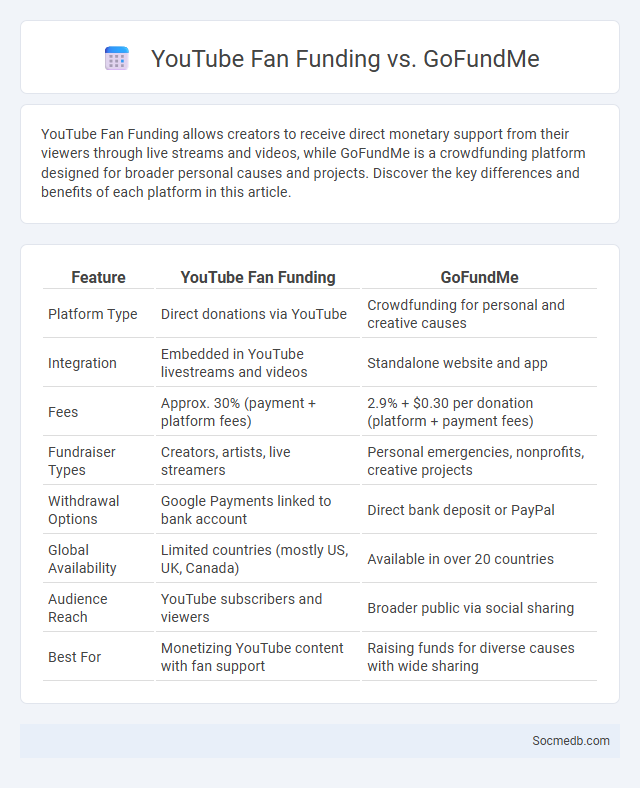
Photo illustration: YouTube Fan Funding vs GoFundMe
YouTube Fan Funding allows creators to receive direct monetary support from their viewers through live streams and videos, while GoFundMe is a crowdfunding platform designed for broader personal causes and projects. Discover the key differences and benefits of each platform in this article.
Table of Comparison
| Feature | YouTube Fan Funding | GoFundMe |
|---|---|---|
| Platform Type | Direct donations via YouTube | Crowdfunding for personal and creative causes |
| Integration | Embedded in YouTube livestreams and videos | Standalone website and app |
| Fees | Approx. 30% (payment + platform fees) | 2.9% + $0.30 per donation (platform + payment fees) |
| Fundraiser Types | Creators, artists, live streamers | Personal emergencies, nonprofits, creative projects |
| Withdrawal Options | Google Payments linked to bank account | Direct bank deposit or PayPal |
| Global Availability | Limited countries (mostly US, UK, Canada) | Available in over 20 countries |
| Audience Reach | YouTube subscribers and viewers | Broader public via social sharing |
| Best For | Monetizing YouTube content with fan support | Raising funds for diverse causes with wide sharing |
Introduction to Online Fan Funding Platforms
Online fan funding platforms enable creators to receive financial support directly from their audience, fostering a sustainable revenue stream beyond traditional advertising. These platforms, such as Patreon, Ko-fi, and Buy Me a Coffee, offer features like subscription tiers, exclusive content, and one-time donations to enhance fan engagement and loyalty. By leveraging social media networks, creators can effectively promote their funding campaigns, build dedicated communities, and maintain consistent interaction with supporters.
What is YouTube Fan Funding?
YouTube Fan Funding is a feature that allows your viewers to support your content financially through direct donations during live streams or on video pages. This service enables content creators to generate revenue while fostering a closer connection with their audience by receiving real-time contributions. By leveraging Fan Funding, you can enhance your channel's monetization and encourage viewer engagement.
Exploring GoFundMe for Content Creators
GoFundMe offers content creators a powerful platform to raise funds directly from their audience, enabling you to support your projects and creative endeavors without relying on traditional sponsorships. Maximizing campaign visibility through compelling storytelling and regular updates increases donor engagement and funding success. Integrating GoFundMe seamlessly with your social media channels amplifies reach, creating a community-driven approach to financing your content.
Understanding General Fan Funding Solutions
Understanding general fan funding solutions involves exploring platforms like Patreon, Ko-fi, and Buy Me a Coffee that enable fans to support creators directly through subscriptions, one-time donations, or merchandise purchases. These tools offer flexible payment options and exclusive content delivery, enhancing fan engagement and providing steady revenue streams. Your ability to leverage these solutions effectively can boost community support and sustain your creative projects.
Key Features Comparison: YouTube Fan Funding vs GoFundMe
YouTube Fan Funding allows content creators to receive direct monetary support from their viewers through monthly sponsorships and one-time donations integrated within the platform, ideal for ongoing content monetization. GoFundMe specializes in crowdfunding for personal causes, emergencies, and community projects, offering easy campaign setup but lacking the ongoing engagement features present on YouTube. Your choice depends on whether you're seeking continuous viewer support via video content (YouTube Fan Funding) or one-time or event-based fundraising (GoFundMe).
Fees and Payout Structures: Which Platform Wins?
Social media platform fees and payout structures vary significantly, impacting your earnings potential and cost-efficiency. YouTube offers ad revenue shares of up to 55%, while TikTok's Creator Fund and Instagram's bonuses often provide fixed amounts or varying percentages based on engagement metrics. Understanding each platform's fee deductions, minimum payout thresholds, and payment frequency can help you choose the most profitable option for your content monetization goals.
Audience Engagement and Community Building
Effective audience engagement on social media drives meaningful interactions, increases brand loyalty, and fosters a sense of community around your content. Leveraging personalized content strategies and real-time feedback helps you create authentic connections that empower users to share experiences and contribute insights. By consistently nurturing these relationships, you build a vibrant online community that supports long-term growth and amplifies your digital presence.
Pros and Cons of Each Fan Funding Option
Crowdfunding platforms like Patreon offer creators steady monthly income but may charge fees and require regular content updates to maintain support. One-time donation services such as Ko-fi allow flexible contributions without ongoing commitment, yet income tends to be less predictable and inconsistent. Subscription-based models provide reliable revenue streams but can deter potential supporters due to recurring costs and the need for exclusive content creation.
Best Practices for Maximizing Fan Support
Engage consistently with your audience by responding promptly to comments and messages, fostering a sense of community and loyalty. Utilize data analytics to tailor your content, ensuring it resonates with your fan base and maximizes interaction. You should also collaborate with influencers and leverage user-generated content to enhance authenticity and expand your reach.
Conclusion: Choosing the Right Fan Funding Platform
Selecting the right fan funding platform directly impacts your ability to monetize content and engage with your audience effectively. Platforms like Patreon, Ko-fi, and Buy Me a Coffee offer diverse tools tailored to different creator needs and revenue goals. You should evaluate each platform's fee structure, community features, and integration options to maximize your support and growth potential.
 socmedb.com
socmedb.com